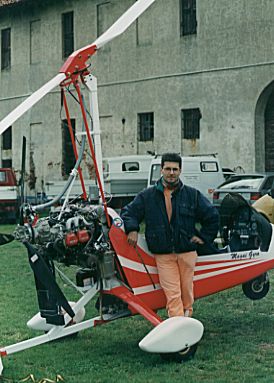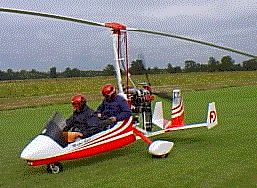
| AVIAZIONE LEGGERA ON LINE - IL GRANDE SITO DELL'AVIAZIONE SPORTIVA ITALIANA |
|---|

|
 The gyrocopter, one of the most fascinating machines one can think of, has flown in our skies for over seventy years. It is the brainchild of Juan De La Cierva, a Spanish pilot of the twenties.
The gyrocopter, one of the most fascinating machines one can think of, has flown in our skies for over seventy years. It is the brainchild of Juan De La Cierva, a Spanish pilot of the twenties.
Distressed by the number of friend pilots who died as a result of fatal stalls, he decided to create a machine which could not be put in such condition. An aircraft which could not stall!
He conceived a free-wheeling rotating wing kept in motion by the relative wind.
This configuration ensured that the aircraft had sufficient lift to hold it aloft in any flight condition, whether slow, translated or vertical flight.
During Second World War, the gyrocopter was used on the German U-Boats being towed aloft as an observation and alerting vehicle. The gyro was made famous also by a flight scene in one of the many James Bond movies.
Let us now take a closer look at a gyrocopter built in Italy by Vittorio Magni, a true expert in this specific field. We are talking about the Magni Gyro M16 Tandem Trainer.
The cockpit features tandem seating and dual controls. It is a very stable, easy to fly and predictable machine designed specifically for training, which gives even neophytes a feeling of safety.
The frame is constructed entirely of TIG welded 4130 chromoly steel tubing. The 27-foot composite rotor is built by Magni Gyro directly. The cockpit and the tail surfaces are also in composite using a sandwich structure. Empty weight is 270 Kg.
The tank, built into the rear seat, has a 50 litre capacity. Range can be extended by installing an auxiliary 30-litre tank which takes the place of the rear passenger. Even so, this tank can be installed or removed in minutes thanks to a quick release fastening mechanism.
A fundamental characteristic common to all Magni gyros are the oversize tail planes with a large horizontal surface. The latter is essential in order to have a stable machine devoid of any "porpoising" tendencies, thus eliminating any possibility of PIO's (Pilot Induced Oscillations).
 The engine is a Rotax 914 turbo which, in combination with a carbon fibre three-blade Arplast ecoprop propeller, designed specifically for such engine, makes for the ideal solution in terms of weight, power and good torque even at low rpms.
The engine is a Rotax 914 turbo which, in combination with a carbon fibre three-blade Arplast ecoprop propeller, designed specifically for such engine, makes for the ideal solution in terms of weight, power and good torque even at low rpms.
The Magni is easy to handle in any situation and, due to the very nature of the gyrocopter, it is only marginally hampered, if at all, by either wind turbulence or updrafts (thermals).
 The actual flight characteristics are very similar to a conventional plane although with a more limited use of the rudder pedals.
The actual flight characteristics are very similar to a conventional plane although with a more limited use of the rudder pedals.
| Empty weight | 270 Kg | max take-off weight | 450 Kg |
| width | 1800 mm | length | 4655 mm |
| height | 2600 mm | fuel capacity | 50 lt |
| rotor diameter | 8230 mm | propeller diameter | 1700 mm |
| max airspeed | 115 mph | max cruise speed | 90 mph |
| max altitude in ground effect | 4000 m | max altitude out of ground effect | 3500 m |
| price | 67.000.000 F.F - VAT not included (ready-to-fly with Rotax 914 Turbo 115 hp and FlyDat) In kit form 63.000.000 FF - VAT not included | ||
| Built by | Magni Gyro - Via della Tecnica, 4 - Cavaria (Va) - Tel. +39 331 218041 - Fax +39 331 217328 | ||
For more information, please contact Renato Chinetti